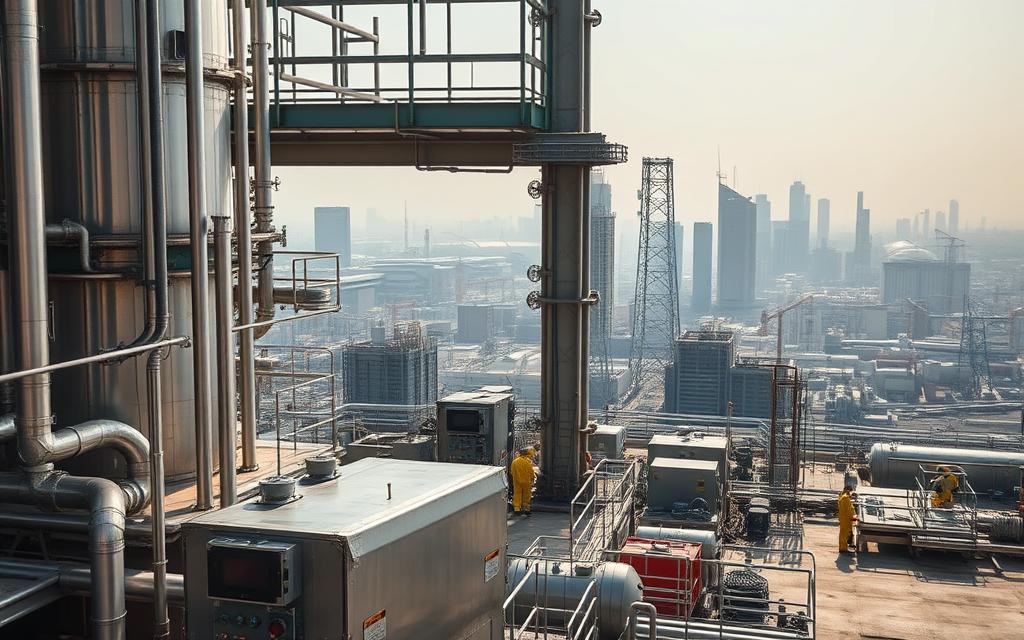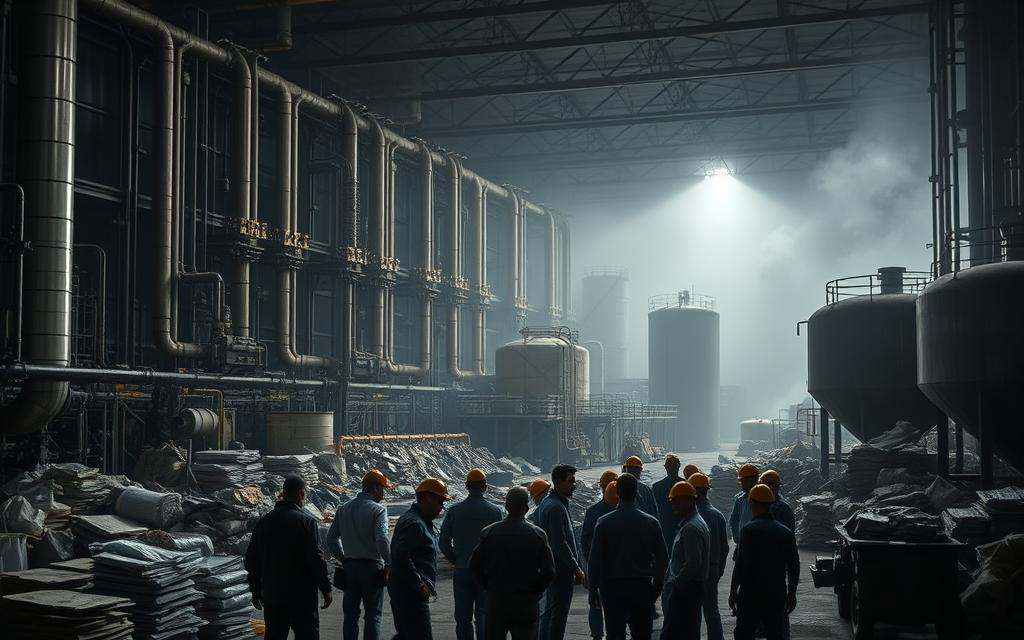In the world of clean technology, Taronis Technologies’ story is quite unique. It started as MagneGas, aiming to change how we use fuel and purify water.
The company changed its name to Taronis Technologies in 2019. This move showed it wanted to grow beyond its first technology.
But, this growth plan didn’t last. By 2020, Taronis Technologies faced serious money problems. It even got a notice from Nasdaq to be removed from the stock market.
This story shows how quickly a promising company can fall. We will look into what led to this downfall in the next sections.
The Origins and Founding Vision of Taronis Technologies
Taronis Technologies started with a big dream to change how industrial gas is made. It was all about using new, green ways to make things better.
Establishment and Early Business Model
Taronis Technologies was born from a smart company founding that saw the power of new energy. It aimed to turn old waste into something new and useful.
The company’s first steps were clear:
- Creating new gas production systems
- Working with partners to make things
- Getting these products to industrial clients
This plan made Taronis a leader in green industrial solutions. It also set the stage for growth.
Initial Market Positioning and Technology Development
Taronis Technologies came into the market with a unique plan. Its plasma arc technology was a game-changer in making metal cutting fuel. It was a better choice than old methods.
The company worked hard to make systems that turn waste into useful gases. This made it a leader in green industrial practices.
“Our goal was to make a cleaner, more efficient way to make industrial gases. We wanted to do it in a way that’s better for the planet.”
The table below shows how Taronis started compared to old ways:
| Feature | Taronis Technology | Traditional Solutions | Environmental Impact |
|---|---|---|---|
| Production Method | Plasma arc conversion | Chemical processing | Significantly lower |
| Resource Input | Liquid waste materials | Fossil fuels | Waste reduction |
| Energy Efficiency | High | Moderate | Improved sustainability |
| Application Range | Multiple industrial uses | Limited specialisation | Broader benefits |
This smart start helped Taronis get noticed early. It showed the world the power of renewable resources in industry. The company aimed to grow big while keeping the planet safe.
The early plan worked well. It drew in early supporters and made Taronis known for green tech.
Taronis Technologies’ Core Technology and Business Operations
Taronis Technologies focused on making industrial gas production better and solving environmental problems. Its unique technology tackled energy and environmental issues at the same time.
The MagneGas Technology and Its Applications
The company’s main innovation was the Plasma Arc Flow™ process. It turned liquid waste into useful industrial products. This system used high-temperature plasma to make a clean-burning hydrogen-based fuel from carbon-rich liquids.
This technology mainly made MagneGas fuel. It’s a new fuel for metal cutting that’s better for the environment than traditional acetylene. It’s great for industries looking for greener options.

The same technology also cleaned water. It could sterilise contaminated water by killing harmful pathogens and organic contaminants with its high-temperature plasma process.
“The dual application of our technology represents a paradigm shift in how we approach both energy production and environmental remediation.”
This ability to serve two needs with one technology gave Taronis a big advantage in the market.
Production Facilities and Distribution Networks
Taronis had many production facilities across the United States. They had 17 operational locations to serve key markets.
These places were set up to make MagneGas and treat water. Each had the right equipment for the Plasma Arc Flow™ process.
The company’s distribution network was also vast. It included both independent distributors and its own channels. This mix helped Taronis reach more customers while keeping quality high.
| Facility Type | Number of Locations | Primary Function | Key States Served |
|---|---|---|---|
| Primary Production | 8 | MagneGas manufacturing | Florida, Texas, California |
| Water Treatment | 5 | Decontamination services | New York, Ohio, Illinois |
| Dual-Purpose | 4 | Both functions | Georgia, Pennsylvania |
Taronis’s wide setup helped it serve many industries. It worked with manufacturing, wastewater treatment, and metalworking across the country. The right placement of facilities made sure goods got to customers quickly and efficiently.
The Meteoric Rise: Expansion and Market Success
Taronis Technologies saw a huge growth period. It became a big name in the industrial gas sector. The company grew from a small startup to a large business with a strong market presence.
Key Growth Milestones and Strategic Acquisitions
The company grew fast through smart acquisitions. In just 13 months, it bought seven welding supply companies. This move helped it grow geographically and gain market share.
Some key buys were:
- Many regional welding supply distributors
- Specialised gas production facilities
- Big customer networks in several states
These deals helped build a strong supply chain. It supported MagneGas production and traditional gas distribution.
Market Penetration and Customer Adoption
Taronis grew its market reach across different industries. Its technology was used in metal cutting, water cleaning, and farming. This showed the company’s technology was versatile and valuable.
It made a big leap by entering North Carolina’s water treatment market. Cities and factories started using MagneGas for water cleaning. This move helped the company reach more customers.
More people started using Taronis products. By late 2018, sales hit over $1 million a month. This showed the growing popularity of MagneGas and traditional gases.
Financial Performance During Peak Years
The company’s finances were strong during its growth years. Taronis saw a 600% revenue increase in some quarters. This success drew in investors and set the stage for more growth.
Some financial highlights were:
- Revenue kept going up each quarter
- Higher gross margins thanks to better operations
- More assets from successful buys
The good finances allowed for more research and expansion. This was the peak of Taronis Technologies’ success and value in the market.
Emerging Challenges and Operational Setbacks
As Taronis Technologies grew, it faced many challenges. The company’s big plans hit several roadblocks. These issues showed weaknesses in what seemed like a strong business.
Technical Limitations and Production Issues
Taronis Technologies had big problems with scaling its MagneGas technology. Turning waste liquids into fuel was harder than in labs. Keeping quality high in bigger batches was tough.
The company had trouble with reliable equipment and upkeep. This led to higher costs and less efficiency. Growing the technology needed a lot of money, which was hard to find.

- Inconsistent gas purity levels across production cycles
- Higher-than-anticipated energy consumption during conversion
- Maintenance downtime affecting production schedules
- Quality control challenges at scale
Market Competition and Changing Industry Dynamics
Market competition got fiercer as big industrial gas companies entered the clean tech field. Taronis faced off against companies with more money and customers. It was up against giants with years of experience.
The industry changed a lot during this time. Customers wanted suppliers they knew and trusted. Prices dropped as big companies used their size to undercut Taronis.
Key competitive factors included:
| Competitive Factor | Taronis Position | Industry Leaders |
|---|---|---|
| Production Scale | Limited capacity | Mass production capabilities |
| Distribution Network | Developing infrastructure | Nationwide coverage |
| Price Competitiveness | Higher production costs | Economies of scale |
| Customer Trust | Emerging reputation | Established relationships |
Regulatory Hurdles and Compliance Challenges
Regulations were a big problem for Taronis Technologies. The company had to deal with different rules in each place it operated. This needed a lot of legal help.
The waste-to-energy field got more rules and checks. Agencies made stricter rules on emissions and waste. This meant more money for monitoring and reports.
Key regulatory challenges included:
- Varying state-level environmental regulations
- Changing safety standards for gas production and storage
- Increased reporting requirements for emissions
- Certification processes for new production facilities
These rules put a lot of pressure on Taronis. Keeping up with the rules cost a lot of money. This was hard during a time when the company was trying to grow.
What Happened to Taronis Technologies: The Downfall
Taronis Technologies had a bright start but then faced many challenges. These problems led to its downfall. The company’s decline was a series of failures that it couldn’t fix.
Financial Difficulties and Cash Flow Problems
Taronis Technologies struggled with money issues. It had trouble keeping cash flowing, which made it hard to run the business and improve technology.
Things got worse when Nasdaq warned the company in late 2018. The exchange said Taronis didn’t meet the share price requirement of $1.00. This was a clear sign of the company’s financial troubles.
Leadership Changes and Strategic Missteps
In late 2018, Taronis changed its entire leadership team. This big change showed the company was in big trouble and trying to fix things.
But, the company kept making bad decisions. It didn’t adjust well to market changes and didn’t use resources wisely. The new leaders had a tough job ahead of them.
The Final Collapse: Bankruptcy and Closure
The company’s problems got worse and worse. Taronis couldn’t get back on its feet or find the money it needed. It faced bankruptcy.
When Taronis couldn’t meet Nasdaq’s rules, it got delisted. This meant it couldn’t raise money by selling shares anymore.
Without money and with a lot of debt, Taronis had to stop operating. Its dream of clean technology ended with a shutdown. Investors lost a lot, and the industry learned a hard lesson about growing sustainably.
Conclusion
The story of Taronis Technologies is a mix of innovation and market challenges. It started with the MagneGas technology, showing great promise. But, it grew too fast and then faced big problems.
This tale teaches us about the risks of growing too quickly in expensive fields. Taronis tried to buy its way to success but faced too much debt. It also struggled with keeping operations running smoothly and competing in the market.
This story is a warning for investing in clean tech. Even the most exciting technologies need careful money handling and realistic growth plans. The Taronis experience shows that success in innovation depends on balancing tech dreams with solid business practices.






